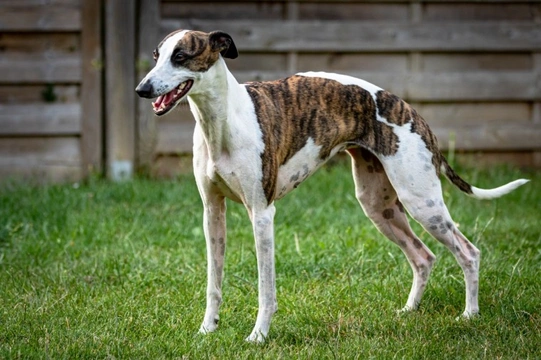
How the conformation of sighthounds differs from that of other dogs
The term “sighthound” is a collective name for dogs that hunt for prey largely by sight (rather than by scent) and is a sub-category of the main classification of hounds.
The sighthound grouping encompasses many popular and well known dog breeds including the greyhound and the whippet, as well as some non-pedigree dog types like the lurcher.
Sighthound breeds and types can vary considerably in terms of their sizes, builds, coat styles and other notable features, but they do all share a very distinctive look that to those who know dog breeds, instantly identifies them as sighthounds; and which actually differs in many significant ways from the conformation of other types of dogs.
The sighthound’s unique conformation is what makes them such good hunters, both in terms of their ability to spot prey and ability to run fast enough to catch it from a start of some distance away, and it can also help you to spot sighthounds and tell them apart from other dogs too when you see them out and about.
In this article we will look at the key ways in which the conformation of sighthounds differs from that of other dogs, and how it helps them to identify and catch their prey. Read on to learn more.
Sighthounds have dolichocephalic muzzles
Sighthounds have particularly long, pointed muzzles, which are proportionately longer and narrower than the natural norm for dogs. This is known as a dolichocephalic muzzle, and the head of the sighthound is long and lean, providing plenty of internal surface area for the exchange of heat and air, ensuring that the dog never has a problem getting enough oxygen to their lungs.
Their backs are highly flexible
The sighthound’s back and spine is more flexible than that of the average dog, and is also long and mobile. This permits them to fully extent their legs and provides sufficient power to the hindquarters to enable them to set off running quickly from a standing start, and catch up with and overtake most other animals.
Their legs are fine and long
A sighthound’s legs are proportionately very long and also lean and fine, which enables them to achieve a long running stride and efficiently cover a lot of ground quickly.
However, this does also mean that their legs are somewhat fragile, and as they are very one track minded when running and not apt to keep an eye on the terrain, does make them somewhat vulnerable to injuries on uneven surfaces.
Sighthounds have deep but narrow chests and large hearts
The chest of the sighthound is narrow when viewed head-on, but deep as it slopes front to back, and this accommodates a proportionately large heart compared to other dog breeds, without adding width that would affect their aerodynamism.
This large heart means that sighthounds can achieve and maintain their fast running pace and provide enough oxygen to the blood thanks to the size of the heart’s ventricles.
Their lungs are highly efficient
Sighthounds have very efficient lungs that in combination with their large hearts and dolichocephalic muzzles, means that they don’t run short of breath when sprinting and helps to support both aerobic and anaerobic sprinting at speed.
Their field of vision and eye position is unique
When it comes to the position of the sighthound’s eyes on their head, this is different from that of other dog types too, and has both advantages and disadvantages in the dog’s day to day life.
A sighthound’s eyes have less overlap between the field of vision of their left and right eyes than other dogs but also, a wider field of vision as a result; this makes them more able to pick up movements on the periphery of their range of vision, but may well give them poorer depth perception in exchange.
Their eyes are finely attuned to pick up tiny movements
The sighthound’s eyes also provide better visual acuity in general than that of other dogs; put simply, they are better attuned to see detail and particularly, movement. This is how sighthounds identify and fixate on their prey, and they can spot minute movements over long distances that other dogs would miss, and then have the speed and propulsion necessary to catch up to them.
Sighthounds are very aerodynamic
The whole build of the sighthound is highly aerodynamic, which helps to ensure that they can reach and maintain their high running speeds.
They are narrowly built with flexible, sloping backs that don’t cause a lot of air drag, their heads are pointed and streamlined with ears that flatten down against their skulls, and their fur is very short and fine and so not apt to result in air resistance that would slow other dogs down.
Sighthounds have evolved over millennia to be the world’s best designed sight hunting dogs, and have the conformation to support it; which is why these are not only the fastest dog types in the world, but some of the most reliably successful hunters too!



